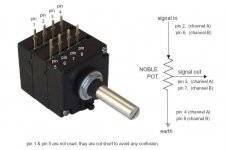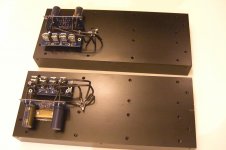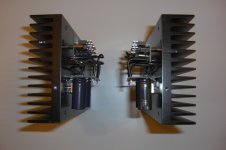which is which?One has a dc offset of 118mv and the other 0.1mv. The second one has no output but the chip does get hot.
I got it fixed! It was the Rm not soldered properly. Thing is so tiny it was hard to tell. I have a dc offset off 121mv on that channel.
I am using a Cambridge Audio V500 Surround decoder as a pre amp. When the volume is all the way down it sounds like there is a relay as there is a clicking sound you can hear. When I measure dc offsets I get about 3mv both channels with the volume all the way down. With volume on it measures 118mv on one channel and 121mv on the other but does not change regardless of volume setting. Does this seem normal? I thought the offset changes with volume level?
I also noticed when the channel settings on the processor are set to 0db I don't get much from the amp. I set it to +3db on the left and right outputs and it seems to have a lot more output capability. It can be adjusted up to 12db per channel. I don't have a proper heat sink set up right now. Using a steel plate with thermal grease and plastic clamps right now so I just have it running very low and it stays cool.
Any comments or suggestions guys?
Regards,
Wayne
I am using a Cambridge Audio V500 Surround decoder as a pre amp. When the volume is all the way down it sounds like there is a relay as there is a clicking sound you can hear. When I measure dc offsets I get about 3mv both channels with the volume all the way down. With volume on it measures 118mv on one channel and 121mv on the other but does not change regardless of volume setting. Does this seem normal? I thought the offset changes with volume level?
I also noticed when the channel settings on the processor are set to 0db I don't get much from the amp. I set it to +3db on the left and right outputs and it seems to have a lot more output capability. It can be adjusted up to 12db per channel. I don't have a proper heat sink set up right now. Using a steel plate with thermal grease and plastic clamps right now so I just have it running very low and it stays cool.
Any comments or suggestions guys?
Regards,
Wayne
The offset changes with volume when potentiometer is connected directly to the amp. When there are coupling caps between potentiometer and the amp, the offset will be at max and not changing. It looks like with volume all way down, a mute circuit is engaged.
If I use GC as integrated amp with pot(50K),which resistor(I presume R2 22K) can be omitted?And of course what can I expect from that?
Help selecting pot or attenuator
I have a premium kit on the way and am gathering the other components. I'm having a hard time selecting a pot or attenuator. Early in this thread a Noble pot was recommended, but partsconnexion doesn't seem to list them any more. Is the Noble a plastic or carbon pot?. There are several step attenuators on ebay from Hong Kong. Would these be a good choice? I'd appreciate any advice. I'm guessing a 25K would be better than 50K. Transformer is 22v and speakers are 8 ohm.
Also, I wonder if it would be OK to mount the pot or attenuator in a separate enclosure. Would the additional connectors and cables be a problem?
Thanks,
Dave
I have a premium kit on the way and am gathering the other components. I'm having a hard time selecting a pot or attenuator. Early in this thread a Noble pot was recommended, but partsconnexion doesn't seem to list them any more. Is the Noble a plastic or carbon pot?. There are several step attenuators on ebay from Hong Kong. Would these be a good choice? I'd appreciate any advice. I'm guessing a 25K would be better than 50K. Transformer is 22v and speakers are 8 ohm.
Also, I wonder if it would be OK to mount the pot or attenuator in a separate enclosure. Would the additional connectors and cables be a problem?
Thanks,
Dave
Noble has a plastic taper and I still have them available (50k). You can also source them from percyaudio: 25K is recommended, but 50k will work fine too.
It's better to mount the pot directly at amp's input, if you have it in separate enclosure you may have problems with impedance matching and drive capability.
Don't remove 22k, it's needed there for protection in case pot fails. It's also needed in case you are using pot value higher than 25K.
However, you can certainly bypass R1 (220R)
It's better to mount the pot directly at amp's input, if you have it in separate enclosure you may have problems with impedance matching and drive capability.
If I use GC as integrated amp with pot(50K),which resistor(I presume R2 22K) can be omitted?And of course what can I expect from that?
Don't remove 22k, it's needed there for protection in case pot fails. It's also needed in case you are using pot value higher than 25K.
However, you can certainly bypass R1 (220R)
Attachments
Last edited:
Anyone experience with passive line level crossover with (bridged) LM4780
Hi there,
i am finishing my amps now and have a rane ac22 crossover to use them one my 2 way speakers with seas w15cy001 and hiquphon OWI. I am using bridged LM4780, only because my current system is fully balanced.
However i am thinking about putting passive line level amps into the amps directly, because i read great advantages to the opamp machines like the ranes and other electronic XO's. Has anyone experience with this with (bridged) LM4780's. I am thinking about a second order PLLXO, because a first order is probably not sufficient for these components. another option would be a tube crossover. My preamp is a passive volume control with a 4 deck 46 step attenuator (acoustic-dimension attenuators). What is your opinion on this and could i use two identical PLLXO's for the + and - signal of a balanced connection?
many thanks
Hi there,
i am finishing my amps now and have a rane ac22 crossover to use them one my 2 way speakers with seas w15cy001 and hiquphon OWI. I am using bridged LM4780, only because my current system is fully balanced.
However i am thinking about putting passive line level amps into the amps directly, because i read great advantages to the opamp machines like the ranes and other electronic XO's. Has anyone experience with this with (bridged) LM4780's. I am thinking about a second order PLLXO, because a first order is probably not sufficient for these components. another option would be a tube crossover. My preamp is a passive volume control with a 4 deck 46 step attenuator (acoustic-dimension attenuators). What is your opinion on this and could i use two identical PLLXO's for the + and - signal of a balanced connection?
many thanks
Magazine review mentioned "Loud" quality of Chipamps
I read the excellent review of Peter's chipamp on his website. The reviewer at HiFi+ made the interesting comment:
"That track and many others have
a slightly ‘loud’ quality with these
amps that when compared to more
powerful designs seems like a slightly
unnatural effusiveness."
I recently read the technology section at the C37 website. They offer a varnish to coat electronic components. I got to wondering if it would tame a gainclone's "loud" quality. Or is the "loud" quality simply because of an underdamped design of the gainclone.
Here is what they had to say at http://www.ennemoser.com/c37theory.html:
"Materials possess their own specific tonal signatures, independently of shape or size, but directly related
to temperature. The mechanism of our ears, made of bone and tissue, has its own unique signature:
Carbon at body temperature = C37structure, where
C = carbon and 37 = temperature in °Centigrade.
These material-specific resonances of our ears would drastically distort our perception of other sounds,
but they are filtered out by the brain, leaving an accurate and apparently objective image of our
acoustic environment. However, this objectivity is deceptive. Although the timbre of our own hearing
mechanism is no longer audible, our subconscious senses transmitted energy. The sound then has a
subjective strength and warmth.
A comparison can help make this clear: Glass bottles thrown into a metal container produce a lot of noise
but little energy, since the sound
signatures of glass and metal have no similarity to C37. On the other hand, sounds made by wooden
objects (close to C37) or similar materials have high energy but without great loudness.
Loudness is used here subjectively and represents the total stress on our ears.
Stress is highest with non-C37 sounds where, due to the lack of acoustic impedance (adjustment),
the inner mechanism of the ear remains virtually in neutral, resulting in large, painful displacements
of the moving parts and eventually, damage. "
Any thoughts?
I read the excellent review of Peter's chipamp on his website. The reviewer at HiFi+ made the interesting comment:
"That track and many others have
a slightly ‘loud’ quality with these
amps that when compared to more
powerful designs seems like a slightly
unnatural effusiveness."
I recently read the technology section at the C37 website. They offer a varnish to coat electronic components. I got to wondering if it would tame a gainclone's "loud" quality. Or is the "loud" quality simply because of an underdamped design of the gainclone.
Here is what they had to say at http://www.ennemoser.com/c37theory.html:
"Materials possess their own specific tonal signatures, independently of shape or size, but directly related
to temperature. The mechanism of our ears, made of bone and tissue, has its own unique signature:
Carbon at body temperature = C37structure, where
C = carbon and 37 = temperature in °Centigrade.
These material-specific resonances of our ears would drastically distort our perception of other sounds,
but they are filtered out by the brain, leaving an accurate and apparently objective image of our
acoustic environment. However, this objectivity is deceptive. Although the timbre of our own hearing
mechanism is no longer audible, our subconscious senses transmitted energy. The sound then has a
subjective strength and warmth.
A comparison can help make this clear: Glass bottles thrown into a metal container produce a lot of noise
but little energy, since the sound
signatures of glass and metal have no similarity to C37. On the other hand, sounds made by wooden
objects (close to C37) or similar materials have high energy but without great loudness.
Loudness is used here subjectively and represents the total stress on our ears.
Stress is highest with non-C37 sounds where, due to the lack of acoustic impedance (adjustment),
the inner mechanism of the ear remains virtually in neutral, resulting in large, painful displacements
of the moving parts and eventually, damage. "
Any thoughts?
gobble de gook.
The "loud" effect may be due to clipping of some of the transients.
That could be due to asking the chipamp to drive low to medium sensitivity speakers.
The "loud" effect may be due to clipping of some of the transients.
That could be due to asking the chipamp to drive low to medium sensitivity speakers.
.The "loud" effect may be due to clipping of some of the transients.
That could be due to asking the chipamp to drive low to medium sensitivity speakers
Just curious what sensitivity number would be considered low to medium? I'm building a pair of speakers with dayton Classic 8's. The sensitivity is around 88 db. I'm hoping a Audiosector classic LM3875 will match up OK.
I'm using 88dB sensitivity 8ohm speaker on a 3886. It plays low level and medium level nicely.
It becomes "loud" if the SPL is raised too high. It clips transients.
It becomes "loud" if the SPL is raised too high. It clips transients.
Passive preamp
Hi everybody,
I just finish my second chipamp with the lm3875 kit. This time, I made a separated PS and a passive preamp. When the amp is connected with the preamp there's no noise, but when the cd is connected to the preamp I can hear a little buzz. But, when my ipod only is connected with the preamp there's no noise.
The preamp is made with an 20K pot and a grayhill switch for channel selection. To connect the amp with the preamp, I decided to try xlr 3 pins (not balanced) pins 2 and 3 for left and right signal and pin 1 for ground. The ground signal (xlr pin 1) at the amp is connected at ground star on a copper bar connecting the 2 boards. I don't know what is the problem.
1-Ground loop ?
2-My xlr setup ?
3-impedance matching ?
I will be glad to have some suggestions.
Hi everybody,
I just finish my second chipamp with the lm3875 kit. This time, I made a separated PS and a passive preamp. When the amp is connected with the preamp there's no noise, but when the cd is connected to the preamp I can hear a little buzz. But, when my ipod only is connected with the preamp there's no noise.
The preamp is made with an 20K pot and a grayhill switch for channel selection. To connect the amp with the preamp, I decided to try xlr 3 pins (not balanced) pins 2 and 3 for left and right signal and pin 1 for ground. The ground signal (xlr pin 1) at the amp is connected at ground star on a copper bar connecting the 2 boards. I don't know what is the problem.
1-Ground loop ?
2-My xlr setup ?
3-impedance matching ?
I will be glad to have some suggestions.
Hi everybody,
I just finish my second chipamp with the lm3875 kit. This time, I made a separated PS and a passive preamp. When the amp is connected with the preamp there's no noise, but when the cd is connected to the preamp I can hear a little buzz. But, when my ipod only is connected with the preamp there's no noise.
The preamp is made with an 20K pot and a grayhill switch for channel selection. To connect the amp with the preamp, I decided to try xlr 3 pins (not balanced) pins 2 and 3 for left and right signal and pin 1 for ground. The ground signal (xlr pin 1) at the amp is connected at ground star on a copper bar connecting the 2 boards. I don't know what is the problem.
1-Ground loop ?
2-My xlr setup ?
3-impedance matching ?
I will be glad to have some suggestions.
Finally I resolve the problem (ground loop).I replug my cd player at another wall socket, and all hum is gone.
Attached you can see the progress of my gainclone with the LM4780 kits from Peter Daniel. The LM4780's will be bridged and are mounted on their heatsinks (left & right) with stips. Power supply star ground is on the heat sink.
The enclosure will be complete aluminium. The rest of the enclosure is being painted. But i did not find a solution yet for a nice front panel.
http://www.diyaudio.com/forums/attachment.php?attachmentid=162166&stc=1&d=1268338696
http://www.diyaudio.com/forums/attachment.php?attachmentid=162167&stc=1&d=1268338696
An identical second amp will be built. After that i will use them in an active setup.
The enclosure will be complete aluminium. The rest of the enclosure is being painted. But i did not find a solution yet for a nice front panel.
http://www.diyaudio.com/forums/attachment.php?attachmentid=162166&stc=1&d=1268338696
http://www.diyaudio.com/forums/attachment.php?attachmentid=162167&stc=1&d=1268338696
An identical second amp will be built. After that i will use them in an active setup.
Attachments
LM4780 resistors value
Hi,
I want to know if the value(22k) for r1 and r2 in the lm4780 is critical. I want to use resistors I actually have in my bin and the nearest value I have now is 21.5K with 1% tolerance. Will it be ok to use 21.5K ?
Hi,
I want to know if the value(22k) for r1 and r2 in the lm4780 is critical. I want to use resistors I actually have in my bin and the nearest value I have now is 21.5K with 1% tolerance. Will it be ok to use 21.5K ?
Peak current of Gainclones
Has anyone ever measured the peak to peak current of the LM3875 / LM3886 / and LM4780 gainclones?
Thanks
Has anyone ever measured the peak to peak current of the LM3875 / LM3886 / and LM4780 gainclones?
Thanks
- Home
- More Vendors...
- Audio Sector
- Commercial Gainclone kit- building instructions


